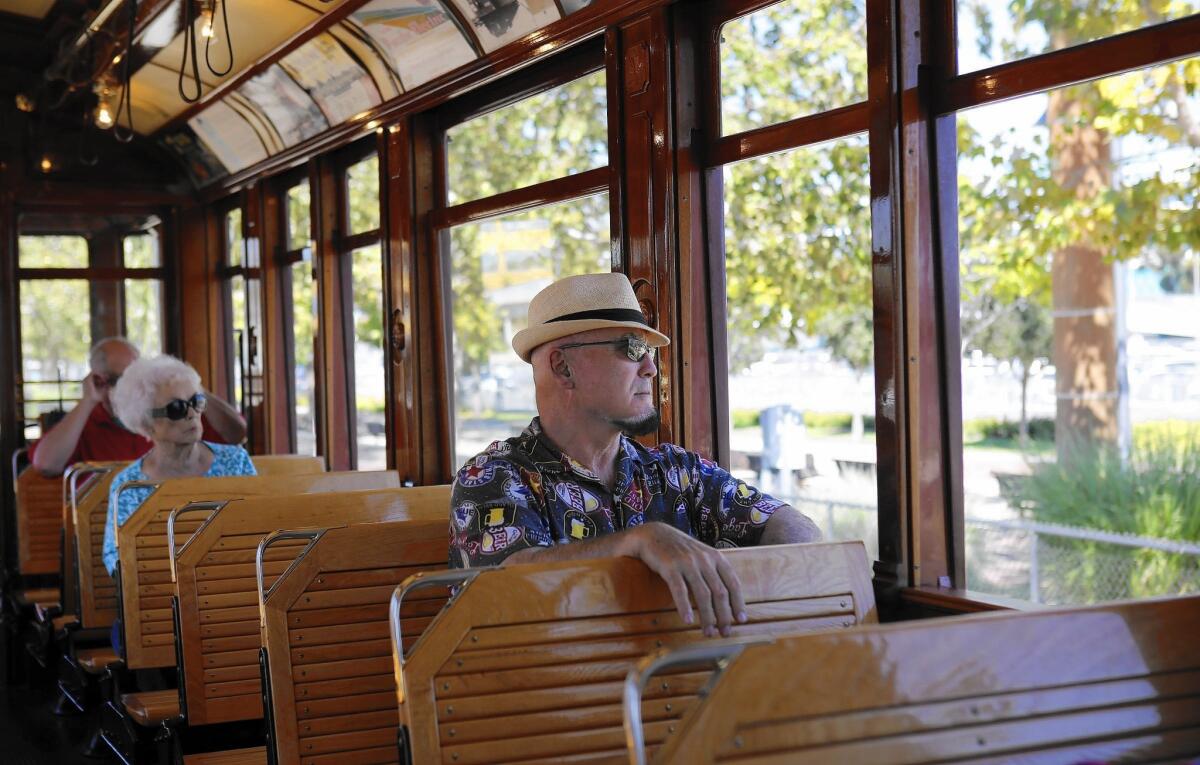End of the line for a remnant of Southern Californiaâs Red Car service

Mark Long of La Mesa and his mother, Fayette Crawford, from San Diego, ride the Red Car in San Pedro.
The remnant of Southern Californiaâs once mighty Red Car rail service is going out of commission Sunday â possibly forever.
A century ago, the Pacific Electric Red Car system was a key transit mode for Southland residents and a driver of suburban growth. Today, an original Pacific Electric car from 1907 and two replicas take passengers along a 1.5-mile route in the seaside district of San Pedro.
The route was opened a decade ago as part of the revitalization of the area, which is home to a bustling cruise ship terminal and tourist attractions. But the line operated at a loss for the Port of Los Angeles, bringing in about $146,000 from 827,000 riders but costing $11.2 million as of 2013.
The rest of the Pacific Electric Red Car system disappeared in the 1950s and â60s as cars began to dominate the streets. For aficionados, the prospect of losing the tiny San Pedro line is another blow.
âThe Red Cars played a major role in early Southern California. In the first half of the century, in the 1900s, that was the only way people could get around,â said David Housh, curator of the Pacific Railroad Societyâs museum in San Dimas.
âHistorically that needs to be remembered, and something like having that system down there keeps it in front of us,â he said.
The mile-and-a-half line will close Sunday so Sampson Way can be upgraded as part of a renovation of Ports OâCall Village. It could eventually reopen at a cost of $40 million, but the alignment, tracks and cars would probably be different, according to port spokesman Phillip Sanfield.
Itâs unclear if the money will be available.
Closing the Red Car line has to be done to modernize San Pedroâs waterfront, a top priority for Councilman Joe Buscaino, who represents the area.
âThis project is crucial for the redevelopment of Ports OâCall,â he said, adding that he looks forward to obtaining âfunding that will allow us to bring a modern streetcar to the L.A. waterfront.â
Ports OâCall is undergoing its first major renovation since the 1960s. Port and city officials hope to attract more visitors to the waterfront with restaurants and park space. Already, the area is home to Crafted at the Port of Los Angeles and the battleship Iowa.
The Red Car line begins just south of the Vincent Thomas Bridge near the World Cruise Center and ends at 22nd Street. When it reopened in 2003 as part of an earlier waterfront revitalization, it marked the first time in 40 years that trains were running on the old Pacific Electric tracks. Now itâs going out of service to make a more formal entrance to the village area.
At a Metropolitan Transportation Authority board meeting this week, L.A. County Supervisor Don Knabe introduced a motion asking that harbor officials delay the closure and, at a minimum, keep the southern part of the line open during construction. The motion was unanimously approved. A Metro report on the Red Car is expected back in 60 days.
âThese are not relics from the past or museum pieces, they are symbolic of our desire to connect, and that connection is made by many people to the future of our public transportation system,â Knabe said.
Henry E. Huntington brought the electric rail lines to Southern California in the early 1900s. He opened lines near his land holdings, allowing Pacific Electric to act as a loss-leader for his real estate developments. By 1911 the system had been sold to Southern Pacific, and in the 1950s the lines closed in favor of buses and cars.
The last line to go was in Long Beach in 1961. Thirty years later, the right-of-way became home to Metroâs Blue Line, the busiest light-rail line in America.
The Orange Empire Museum in Perris has the lineâs Hollywood Car from the 1920s and the Blimp, which ended service in 1961. Disneylandâs California Adventure has a trolley service inspired by the Red Car lines of the 1920s, and the end of the Red Carâs domination was depicted in âWho Framed Roger Rabbit?â
For the 75-year-old curator at the Pacific Railroad Societyâs San Dimas museum, riding the Red Car was simply how he got from his home in Monrovia to the city as a child.
âItâs such a part of our heritage,â Housh said, âand to pull it out, especially after all they went through to set the system up â to me, itâs a crime.â
More to Read
Sign up for Essential California
The most important California stories and recommendations in your inbox every morning.
You may occasionally receive promotional content from the Los Angeles Times.










